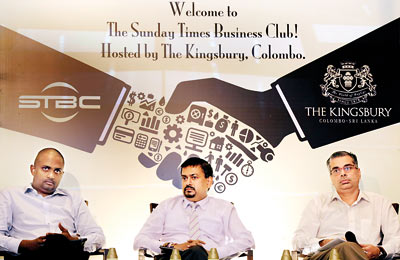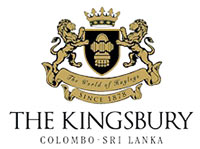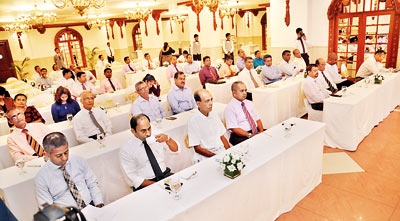Authentic Sri Lankan experience sells, says tourism industry

Panellists at the Sunday Times Business Club meeting. From left:Cinnamon Resorts and Hotels Brands Vice President Dileep Mudadeniya, Sri Lanka Tourism Development Authority Director General Malraj Kiriella and Serendib Hotels Director and Economist Murtaza Jafferjee. Pic by M.A.Pushpa Kumara
The changing climate of tourism has impacted on Sri Lanka’s formal and informal sectors with more travellers wanting to live the experience on a budget tour while being environmentally conscious as well. These were brought to the fore at a discussion on “Tourism Sri Lanka: Mass market or High end” conducted by the Sunday Times Business Club on Tuesday at The Kingsbury in Colombo.
It was the first meeting at the club’s new host hotel, The Kingsbury Colombo. In the audience in addition to the club members were special invitees and veterans in the industry – Malin Hapugoda, former MD-Aitken Spence Hotels; Chandra Mohotti, Senior Vice President of Galle Face Hotels Group; Anura Lokuhetty, former President Tourist Hotels Association of Sri Lanka and Devindra Senaratne, President of the Sri Lanka Association of Inbound Tour Operators.
Future Travellers
Serendib Hotels Director and economist Murtaza Jafferjee speaking on the mass or upmarket traveller to be targeted, highlighted how a couple visiting Sri Lanka were travelling on a budget. They started out at a 5-star hotel and then continued their round trip staying at a number of informal accommodation units and touring the country from three-wheelers to vans, bicycles and even took the train to gain the real experience of visiting the sights and sounds of the island.
He noted however, that the two were highly educated and would become a repeat traveller likely to spend more on a future visit. All of this has become possible today with the increasing access to the Internet by most of these accommodation units in the informal sector that are able to compete with the other regulated and formal sector, he explained. Mr. Jafferjee pointed out that regulating the informal sector was something that was posed by those in the formal sector but he noted that there needs to be an incentive for such regulation.
Incentive to register would be to obtain professionalism and training and other benefits to keep their accommodation units functioning without imposing restrictions, he noted. With Sri Lanka continuing to increasingly attract more travellers from Western Europe who spend more nights in the country at 44 per cent as opposed to Indian or Chinese visitors from Asia at 29 per cent, Mr. Jafferjee observed that travelling cost to Colombo was reduced by most of the Middle Eastern airlines compared to the local carrier.
In this respect, he explained that those visiting the country and staying in the informal sector usually travel out to gain an authentic Sri Lankan experience like living with locals at an affordable cost and staying in accommodation units away from key places they want to visit that would allow them to travel around the country. As a result the industry needs to create a better matching experience, raise awareness and increase on price transparency and deliver an experiential product, he said.
Mr. Jafferjee also pointed out that the mass market or upmarket alone will not suit the country but it had to be complementary without focusing on just one segment. About 10-15 per cent of tourists were domestic travellers and in this regard he noted the fundamental issue was affordability since most locals found it cheaper to holiday in Thailand. “We are not that cheap anymore,” he pointed out adding that the nature and culture is not just going to drive the industry in the future in view of international visitors.
 Authentic experience
Authentic experience
However, Sri Lanka Tourism Development Authority (SLTD) Director General Malraj Kiriella said that most travellers visit the country for its coastline, nature, people, religious and multi cultural events and the authentic experience. He also pointed out that Sri Lanka’s authenticity was what attracted at least 30 per cent of tourists who were found to be repeat visitors to the country. Tourist sites would be transformed to increasingly attract visitors to places like the cultural triangle sites, East coast beaches, Nuwara Eliya, Badulla and the upcountry region and the introduction of new routes and zoning, he said.
In addition the mega tourism resorts of Yala, Kalpitiya, Jaffna and Mannar islands would be developed as well as the Passikudah National Holiday Resort; and the model beach development on the South coast of Bentota and in the Mannar and Jaffna regions, Mr. Kiriella explained.
Strengthening of legislation and regulation would also be carried out to establish new guidelines to prevent any negative impacts, he said.
In addition, there would be classification, licensing and impartial rating of accommodation units in the formal and informal sectors.
Moreover, he pointed out that there would be quality professionalism required in the industry that would be carried out with the absorption of the informal sector tourist establishments; authorizing tourist friendly eating places; improvement of workforce; conduct awareness and training programmes in addition to strategic capabilities of SME managers; introduce frontline service delivery systems using IT and tourist service providers.
 Development Plans
Development Plans
Mr. Kiriella observed that in linking culture they would develop a master plan for development of Anuradhapura, Polonnaruwa, Kandy, Sigiriya and Dambulla tourist attractions. There would also be development of entertainment and recreational facilities and improve on infrastructure and ancillary facilities for visitors to the country, he said.
During the discussion, Mr. Kiriella pointed out that they would establish guidelines for the construction of hotels along the coastal belt at a maximum height of 16 metres and restrict the room capacity per acre for accommodation units. Other areas in which regulation would be forthcoming would be in health tourism where the private sector has taken an initiative to explore, and the government would bring in regulation for the spas as well, he said .
Holidaymakers in Sri Lanka
It was found that over 32,000 tourists were staying at rooms below three stars and at least 70 per cent of these bookings were from online websites like booking.com, Cinnamon Resorts and Hotels Brands Vice President Dileep Mudadeniya said at the meeting. He noted that about 30 per cent of visitors were young people between 20-29 years; at least 50 per cent of bookings would generally take place 30 days before the arrival date; 51 per cent making their own arrangements resulting in not using services of travel agencies; and about 80 per cent of visitors on non-packaged tours.
Mr. Mudadeniya queried as to whether the industry should create the experience for the traveller as was done in other countries which he explained by highlighting a particular overseas hotel that would give their guests a ghost experience in the middle of the night by taking them on a tour of a haunted house with no visible ghost though. “In today’s context the brick and mortar sometimes don’t necessarily command the premium,” he said adding that holidaymakers were more interested in paying more for the experience.

Members and invitees at the meeting
As a result at least 60 per cent of room capacity is going to be less than three stars for the next three to four years, he explained adding that in this context the private sector needs to be more creative. The informal sector was found to dominate the tourism industry in most countries in Asia and this was also clearly evident in Sri Lanka as well with most visitors eyeing the budget accommodation units. The discussion also pointed out at how the industry needed to not just attract the high spenders but also the backpackers who might turn up at the five star hotels for a dinner which was found to be happening even today in the country.
These visitors would frequent the more affordable places to spend the night but spend more money and time outside at tourist attractions and visiting the not so traditional sites by establishing links with locals and taking rides on bicycles and three-wheelers that was more fun and created a unique experience for the discerning traveller.


